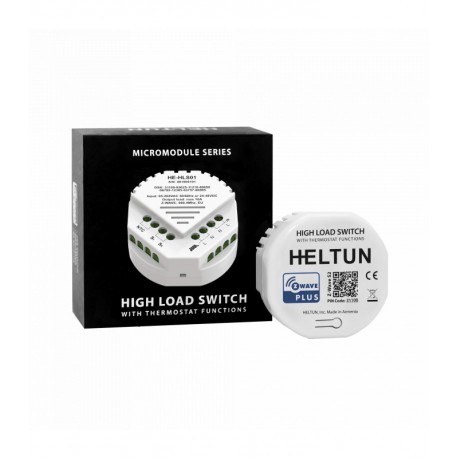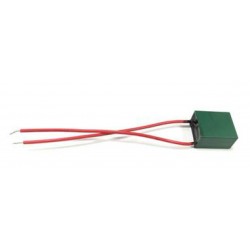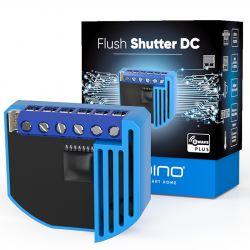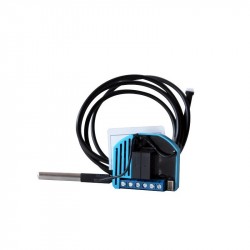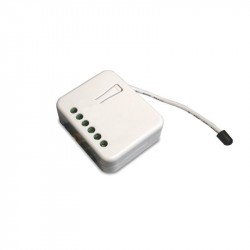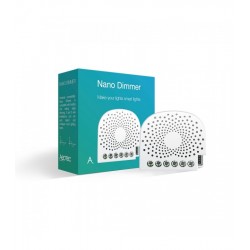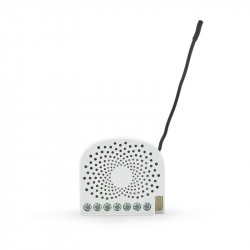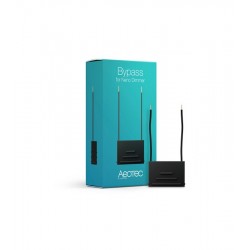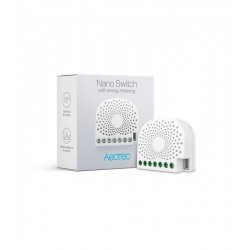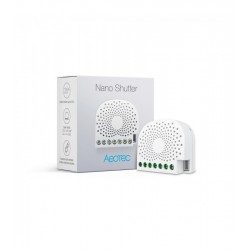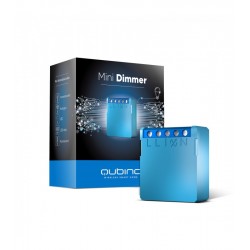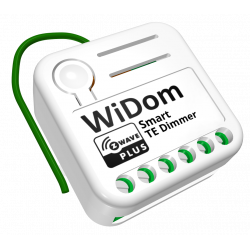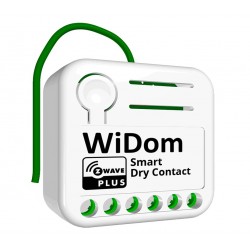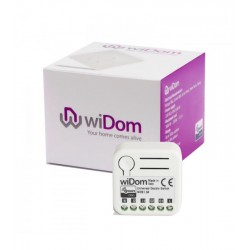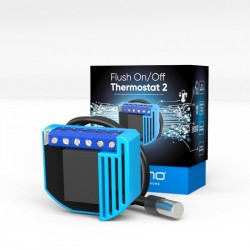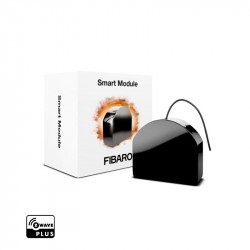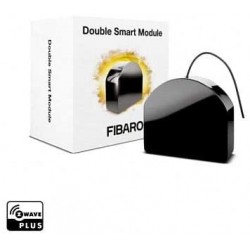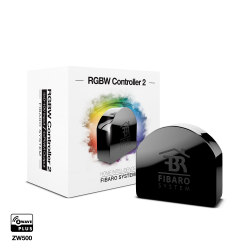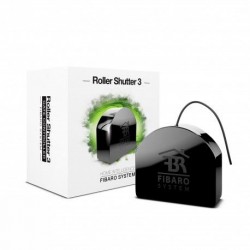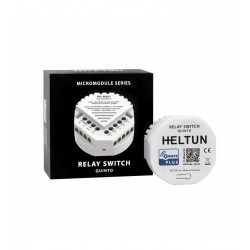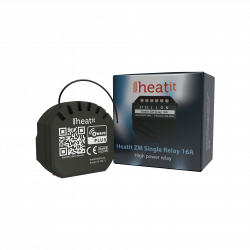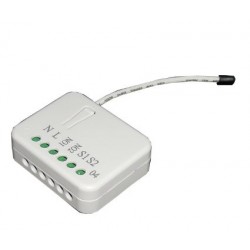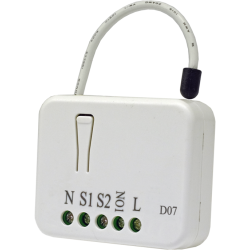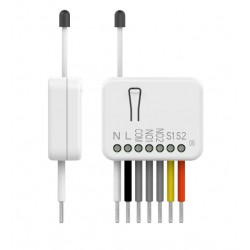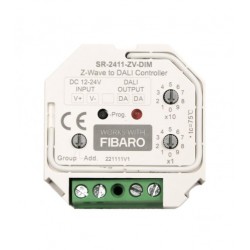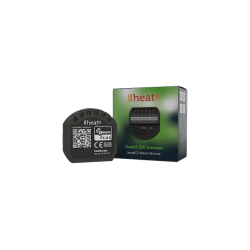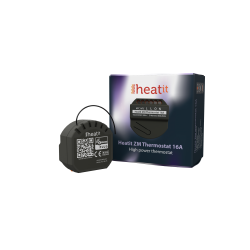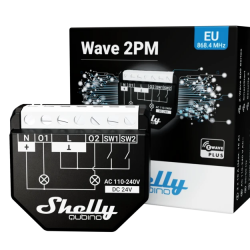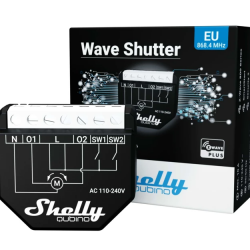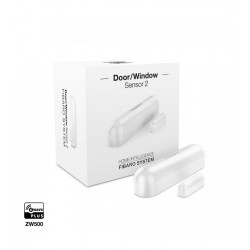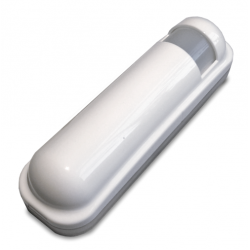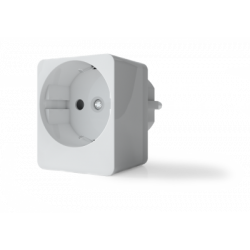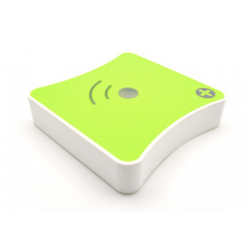No products
Prices are tax included
Product successfully added to your shopping cart
There are 0 items in your cart. There is 1 item in your cart.
HELTUN - 16A Z-Wave + 700 high charge switch module
HE-HLS01
New
Heltun's high power switch module is a Z-Wave + device with thermostatic functions. It is also suitable for luminaires or fixtures up to 16A.
Out of stock
- Remove this product from my favorite's list.
- Add this product to my list of favorites.
Technical characteristics
| Technology | Z-Wave Plus |
More info
YOUR COMFORT MATTERS.
What are the most important aspects of your comfort? Is it the general room temperature? Remote or automatic control of appliances, sockets or groups of lights? Or maybe something else? Whatever the need, HELTUN guarantees that it will take care of it.
Take control
HELTUN's advanced zero-crossing technology offers a significant increase in system longevity and reliability. The relay supports a maximum load of 16 amps and is suitable for controlling electric heating, as well as electrical outlets, appliances or lights.
Incredibly small and smart
The heavy-duty switch with thermostat functions brings incredible capabilities to any connected appliance. Makes electrical outlets and lights "smart" with advanced remote control, control, and programmability. You can now enable internet-connected thermostat functions in cases where the display and local controls are not required, such as rooftop or driveway defrosting systems, etc. This brings the convenience of smartphone application control and programming to "dumb" devices such as electrical outlets and panels, electric water heaters, radiators, fireplaces, and underfloor or underfloor defrosting systems.
At 26mm deep, the switch module is also incredibly small, fitting into any rectangular, round or square electrical junction box, even behind a connected device.
Inputs, outputs and sensors
You can connect an NTC temperature sensor to monitor the ambient or radiant temperatures of the floor / ceiling system. This sensor can be installed on the wall, under the floor or on the ceiling, allowing you to accurately measure surface temperatures. The HELTUN Heavy Duty Switch Module is fully compatible with third-party NTC sensors, so there is no need to replace an existing sensor when installing.
You can also control the module by connecting it to an external system - such as an alarm system - using a pilot wire that could be programmed to automatically reduce the temperature when the house is empty or turn on the electrical outlets / lights when people come home.
Know your energy consumption
HELTUN's integrated power consumption system accurately monitors the amount of power that has passed through its high load switch module during a particular day, week or month. With the switch module, you can determine the amount of power used by major appliances, entertainment systems, computers, small appliances, or complete lighting systems.
Heltun has also designed the circuit to draw almost zero watts of power when in standby mode. This saves you energy and money even if your home is equipped with many HELTUN products.
Thermostat modes
Although the Heavy Duty Switch Module has no display or buttons, all of its thermostat functions are accessible through a Z-Wave controller. Here are the available thermostat modes.
COM (Comfort), ECO (Energy Saving) and VAC (Vacation) modes maintain the temperature you have specified using the Z-Wave controller.
DRY mode switches to a higher temperature to heat quickly to dry floors after washing. The DRY mode returns to the previous mode after the specified time.
MAN (manual) mode allows you to override any current mode or program and manually turn the heater on or off using your controller interface.
See the controller manual for instructions on how to set the temperature set points and modes for the connected thermostats.
Time mode: Thermostat
You can reduce your electricity bill and help the environment simply by using the TIME mode through your Z-Wave controller. Adjust the comfort level of your home according to your family's habits by reducing the temperature while everyone is away and increasing it in the evenings and mornings.
People spend an average of 12 to 14 hours a day at home. The rest of the time, an empty house needs minimal heating. And since your family sleeps most of the time at home, you can make a big difference by setting your home comfort level at 18 ° C at night, which is considered the optimal temperature for sleeping.
Using the TIME mode and your controller, set different temperatures for morning, day, afternoon, or night. For example: "Morning" mode can start at 7:00 am at 23 ° C and then switch to "Day" at 8:30 am at 17 ° C when everyone is at work and school. The "Night" mode can start at 4:00 pm at 22 ° C and then switch to "Night" at 11:00 pm at 18 ° C. Adjusting the temperatures for these four periods can save a lot on your electric bill, and you can adjust the weekdays for the weekend days.
Time Mode: Other Devices
The heavy duty switch module can be connected to products other than those controlled by a thermostat, such as electrical panels, outlets, and lighting. The time mode provides an extremely powerful ability to schedule on and off cycles for groups of connected devices. Here are some ways that Time Mode can add convenience, comfort, security, and savings to your home:
Turn off electrical outlets connected to energy-consuming appliances such as washers, dryers, and dishwashers during periods when electricity is expensive.
Turn off your electric water heater / boiler on vacation or even at night and turn it on again in the morning.
Turn off electrical outlets when family members are at work or on vacation to prevent a fire from leaving an appliance running (kettle, iron, curling iron, etc.).
Pre-program all house and patio lights to turn on before visitors arrive at your vacation home.
And as with the thermostat functions of the high-power switch module, a controller can assign connected appliances to ON or OFF during the morning, day, afternoon or night periods. This can allow you to easily turn off the plugs connected to game consoles at night, or to program all exterior lights to turn on at night and in the morning. The possibilities are only limited by the creativity of the user.
Powerfully customizable
There are eight different modes that can be selected for the heavy duty switch module using a pilot wire to another device (e.g. alarm panel, wall switch, etc.):
Revert State - If on, off when circuit is closed (or if off, on).
Momentary - On when pilot wire circuit is closed, off when open.
Momentary Reverse - Off when pilot wire circuit is open, on when closed.
Switch Only - When the pilot wire circuit is closed (ie shorted).
Shutdown Only - When the pilot wire circuit is closed (i.e. shorted).
Change Mode - Change to a specific thermostat mode (preset in the settings menu).
The relay output of the Heavy Duty Switch Module can also be controlled by an internal timer. For example, after turning on the switch, it can be set to automatically turn off later (or vice versa: turn on after being turned off).
Timer (ON and OFF) - Lights when the pilot wire circuit closes, then turns off after a specified time.
Timer (OFF and ON) - Turns off when the pilot wire circuit closes, and turns on after a specified time.
Make your switches incredibly smart
Is your DIN rail a "stupid" rail?
Since the HELTUN Heavy Duty Switch Module can handle up to 16 amps, it is a perfect complement to your switch panel to monitor and control groups of devices from the Internet through a Z-Wave gateway, such as:
The sockets connected to the main devices
Plugs connected to small devices with high loads
Whole groups of sockets
Whole groups of lights
The mounting adapter is available as an accessory for the heavy duty switch module to fit standard DIN rails (50mm wide), or it can also be mounted directly to the wall using the supplied screws and plugs.
Security
The heavy duty switch module can improve the security of your home in a number of ways.
Overload - If the Heavy Duty Switch Module detects too much power from connected appliances - such as multiple connected electrical outlets - it will automatically shut down to protect itself from circuit overload. This is useful for many applications where multiple loads are connected to a heavy load switch module.
Overheating - The Heavy Duty Switch Module also continuously monitors temperature providing multiple layers of protection. With an external NTC sensor, it monitors the temperatures inside the junction box allowing automatic disconnection and notification to the user if a plug gets too hot. It can even warn the user of rising temperatures before reaching a critical shutdown level, after which it will automatically close the output when it crosses a dangerous threshold.
High Load Delay - If a family member leaves a high-energy appliance on for a long time - such as an iron plugged in for more than an hour - the High Load Switch Module can be configured to automatically turn off connected plugs to avoid a fire.
Users can set high load shutdown limits, time and temperature limits, and notification settings in the heavy duty switch module settings using a Z-wave controller.
Easy to install
The HELTUN heavy duty switch module can be easily installed in any standard electrical junction box (rectangular, square or round) in just a few minutes. Installation should only be carried out by a person trained in handling high voltage electrical systems.
Z-Wave Plus V2 certified
You can connect HELTUN devices to a home automation controller using the latest Z-Wave Plus V2 700 platform. HELTUN features advanced Smart Start technology for easy system integration and the S2 security framework with AES 256 encryption for seamless handover. secure data.
This heavy duty switch module is compatible with all certified Wave Z controllers and devices that correctly implement the Wave Z classes of switches and thermostats. With a Z-Wave controller, you can manage all the functions of the switch module via of a mobile application, including temperature and mode changes, displaying energy consumption graphs and much more.
Up to 10 separate devices can be connected to the HELTUN heavy duty switch module. You can combine it with any Z wave compatible on / off switch or any other switch to control different air conditioning systems in one room. You can even connect motion detectors and switch high load switching modes when people are detected in the house.
HELTUN units are compatible with all Z-Wave frequencies for different countries (Europe, Russia, Israel, Australia, USA, India, Hong Kong, China, Japan and Korea). The correct frequency can be selected in the device menu.
HELTUN periodically releases new firmware for the device with additional features that can be remotely updated through an encrypted OTA (Over-The-Air) process.
FUNCTIONS:
Inclusion / exclusion options in a Wave Z network:
It is not guaranted
S0 Safe ...
S2 not allowed, S2 allowed with key
Association control of 10 network devices
6 operating modes: COM, ECO, VAC, DRY, TIME, MANUAL
Four programs: morning, day, afternoon and night.
Program and set the temperature (heaters)
Programming only (other devices)
Eight retransmission modes (using a pilot wire to another device):
Reverse the state
Momentary
Invert momentarily
Turn on only
Turn off only
Switch to
Timer (ON and OFF)
Timer (OFF and ON)
Three security modes with notification and automatic shutdown:
Overload (automatic shutdown in case of overload)
Overheating (automatic shutdown in case of output overheating)
High load delay (notification and automatic shutdown when high load delay is exceeded)
It can be used with various NTC sensors: Resistance value range: 1k © - 100k ©
Calibrating the temperature sensor
Temperature setting ranges: 4 ° C - 37 ° C
Temperature limiter
Set the temperature hysteresis
Temperature measurement: Centigrade (° C) or Fahrenheit (° F)
Reset the energy consumption meter
Factory reset button
Updating the OTA (Over-The-Air) firmware
TECHNICAL DATA :
Dimensions: 50x50x26 mm
Material: Fire retardant plastic
White color
Operating temperature: 0 °! at + 60 °!
Power supply: 85-265VAC 50Hz / 60Hz, or 24-48VDC
Power Consumption: <1W
Maximum resistive load: 16,4000W @ 220V
Relay switching with HELTUN Advanced Zero Pass Technology
Relay life: 100,000 cycles
External soil temperature sensor
NTC 10k © (included)
Measurement range: -30 ° C to + 80 ° C
Accuracy: ± 0.5 ° C
Energy consumption meter
IP class: IP21
Z-Wave Plus V2 SDK: V7.11
Z Wave Module: ZGM130S
Assembly:
Electrical connection box: round, rectangular or square - minimum depth 40 mm.
Optional adapter for DIN rail mounting (50mm wide) or to screw into the wall
Extended Z-Wave info
Manual download HERE.
If successful, the LED indicator will blink white for two seconds then the device will reboot.
The factory reset will change all the Parameters to their original factory default values and will also Exclude the device from any Z-Wave network.
Note: Please use this procedure only when the network primary controller is missing or otherwise inoperable.
1. Ensure the HE-HLS01 is Powered On and the LED indicator blinks red slowly (i.e. it is excluded).
2. Start the Inclusion Mode from the gateway/controller.
3. To start the inclusion process on the HE-HLS01:
a) if you want to use the device as a “Binary Switch”, double-press the service button on the device (with no more than a one-second interval between presses).
b) if you want to use the device as a “Thermostat”, press four times the service button on the device (with no more than a one-second interval between presses).
4. The LED indicator will blink green quickly.
5. If the inclusion has been successful, the LED indicator will turn green for three seconds then continue slowly blinking green continuously while the HE-HLS01 is Powered On.
6. If the inclusion was not successful, the LED indicator will turn red for three seconds then continue slowly blinking red continuously while the HE-HLS01 is Powered On. In that case repeat the inclusion process (2-5) above.
Depending on the inclusion method it is possible also to use that as "Thermostat".
To start the inclusion process on the HE-HLS01:
a) if you want to use the device as a “Binary Switch”, double-press the service button on the device (with no more than a one-second interval between presses).
b) if you want to use the device as a “Thermostat”, press four times the service button on the device (with no more than a one-second interval between presses).
The altered capabilities are described in the corresponding sections in user manual:
Functions & Features
Device type “Binary Switch”
Device type “Thermostat”
Depending on the number of button presses (two or four) during the inclusion process HE-HLS01 could function as either “Binary Switch“ or “Thermostat“.
In case if the device is already included in Z-Wave network and there is a need to change the device type, it should be removed from network and re-included with the corresponding type.
1. Ensure the HE-HLS01 is Powered On and the LED indicator blinks green slowly (i.e. it is included in a Z-Wave network). 1. Start the Exclusion Mode from the gateway/controller.
2. To start the exclusion process on the HE-HLS01, double-press the service button on the device (with no more than a one-second interval between presses).
3. The LED indicator will blink red quickly.
4. If the exclusion has been successful, LED indicator will turn red for three seconds then continue slowly blinking red continuously while the HE-HLS01 is Powered On.
5. If the exclusion was not successful, the LED indicator will turn green for three seconds then continue slowly blinking green continuously while the HE-HLS01 is Powered On. In that case repeat the exclusion process (2-5) above.
Note: If the HE-HLS01 has previously been part of a Z-Wave network and not Excluded since, Inclusion is not possible without first performing an Exclusion or Factory Reset procedure.




